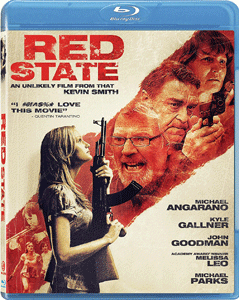I’m a horror fan, but sometimes I watch a movie that makes me say “Wait, do I really like horror?” Writer-director Kevin Smith’s “Red State” (2011) is so horrific in its first act, when a group of sex-driven teenage boys get entrapped by a religious cult outside of town, that I had to stop and finish it the next day. It was hard to restart, even with the potential of seeing the bad guys get what’s coming to them in the second half.
But that’s my hang-up. There’s no question “Red State” is well crafted, both as a screenplay and as a finished film. The movie is Smith (“Clerks III”) saying “See, I can make a great horror movie if I want to – I’m just generally not interested in doing so.”
Textual statements, too
“Red State” makes statements within its text too, about cult religions and government secrets. And it features a thrilling shootout in the back half that you can’t look away from. The sequence includes those shaky but ultra-crisp close-ups that war and action movies had adopted in the wake of “Saving Private Ryan.”

“Red State” (2011)
Director: Kevin Smith
Writer: Kevin Smith
Starring: Michael Parks, Melissa Leo, John Goodman
Sometimes death is abstract enough in horror movies that we don’t dwell on it. But the cult’s method of killing their captives by wrapping them in plastic first to avoid the blood spill is strikingly inhuman and dehumanizing.
We brace ourselves for these killings – of teens who are considered sexual deviants (which means they are interested in any kind of non-marital sex) – even as we listen to Abin Cooper (Michael Parks) preach to his flock. He is disturbingly persuasive through sheer charisma. Smith further emphasizes the deeply disturbing scene by cutting to children watching, swinging their legs in bored bare comprehension.
Parks gives one of the two most memorable performances. The other comes from John Goodman as ATF agent Joseph Keenan. He’s a down-the-middle, by-the-book, morally decent official who wants to retire with some savings rather than have his wife clip coupons.
Critiques to go around
Through Keenan and a cool-with-the-kids school teacher in an opening segment, Smith demonstrates a Pollyanna view of government employees. But he balances that with cynical (but likely accurate) statements elsewhere.
Notably, Keenan is ordered by his off-screen superiors to kill everyone in the compound – including children and captives. This is so the government can control the narrative. But as “Red State” illustrates via a mini-thread with young cult member Dana (Kaylee DeFer) and captive survivor Jarod (Kyle Gallner), if the government wanted to do things above-board, it could.
There are witnesses available to form a strong court case. Then the cult’s children wouldn’t have to be killed. But as the ATF officials admit to Keenan in the debriefing, it’s easier to kill them all – or at least to lock them up without trial forever. After all, the first option is legal as long as the details are buried in the shootout’s chaos, and the second is legal under the Patriot Act.

Smith is no fan of religious cults, but he’s equally critical of corrupt government. In this way, “Red State” is actually rather safe: It’s hard to watch at first, but it’s hard for anyone to get mad at the film in the end.
Everyone’s awful
Both sides of the conflict are unabashed bad guys. Keenan enters as a refreshing moral touchstone in the back half after the sheer terror of the first half (even though the politicizing of the word “terrorist” becomes a theme after the early out-of-the-box terror).
“Red State” is unsubtle with its messages. But as a story, it’s gripping in a way that’s just shy of how Tarantino might do things. Smith shifts points of view and genres. We’re intimately traveling alongside a character, only to see them killed off. Then we’re intimately with another. This approach requires that we be invested in each POV character, and indeed we are thanks to the performances and the tense situations.
Smith crafts a horror-action commentary that’s great yet also seemingly effortless. It probably wasn’t truly effortless; his effortless films are probably the bad ones. “Red State” is one of his good ones; it stands out among his lost decade of the 2010s.

